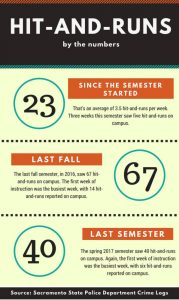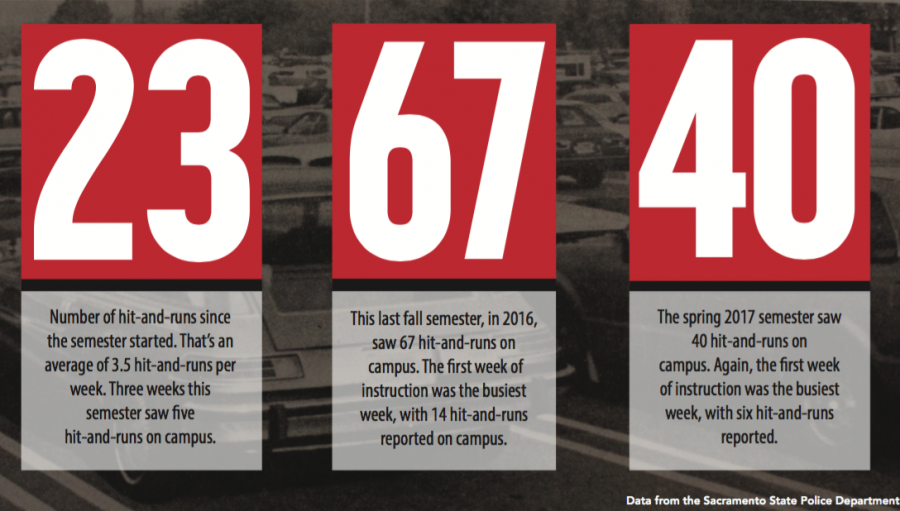Students use social media to report hit-and-runs on campus
Barbara Harvey — The State Hornet
Sacramento State students are now turning to social media to sleuth and get advice on hit and runs on campus.
October 10, 2017
The last thing any Sacramento State student wants to deal with after rush hour traffic and increasingly crowded parking lots is grazing another vehicle while trying to park.
While some students would leave a note with a name and number, others would continue on to class. Now, social media are playing a bigger role in how students handle these brushes on campus.
Christine Neiger, a junior psychology major, witnessed a hit-and-run in Parking Structure I by the tennis courts. She then took a picture of both vehicles’ license plates and posted it on Facebook to a networking and resource group for transfer students at Sac State.
“I watched her right in front of me try to fit into a tight spot, and after a while, she looked like she was going to try to leave,” Neiger said. “There were cars waiting on either side of her, so I think she felt really pressured for time.”
(Story continues below the map, and let us know in the comments on where else you’ve witnesses or been involved in a hit-and-run)
Neiger said she was inspired to take pictures of the plates after seeing a similar post on the group’s Facebook page from another student about a hit-and-run witness leaving a note on the damaged vehicle.
Social media are also resources for stressed-out students, who hit another vehicle, to find out what to do next.
 Rin Carbin — The State Hornet
Rin Carbin — The State Hornet
Jessica Montiel, a senior communication sciences and disorders major, used her sorority’s group page on Facebook to find out what to do after backing into another vehicle while parking in Student Lot 8 by Hornet Stadium.
“I was there early; I had an hour before I had to go to my class, so I just chilled there for a while,” Montiel said. “They didn’t come, and it was down to the wire. I posted on my Facebook chat with my sorority and was like, ‘Hey guys, this is what happened, what do I do?’ and they (said), ‘Just leave a note if you have to go to class and leave your information.’ ”
Jon Parker, a Sacramento State police officer, advised students that even if there is no time to wait for the other person to return or leave a note, students can call the on-campus police station and leave their information.
“One of the things that we run into often is if (students are) able to contact the suspect party of the hit-and-run,” Parker said. “One of the most common reasons is they were late to get to class, so they couldn’t stick around and follow through with their obligations or leave a note or contact the police.
“And one thing I always suggest is you can contact us and tell us that you were involved with a collision, and we can work with you to make sure that we get in contact with you later after class.”
According to the available seven weeks of Sac State Public Safety crime logs, 23 hit-and-runs have been reported since the semester started. During the fall 2016 semester, 67 hit-and-runs were reported on campus, with 14 being reported in just the first week of classes.
For the current semester, Parking Structure I and Parking Structure III have had the highest rates of hit-and-runs, with six and seven hit-and-runs respectively.
The parking structures are the most frequent places for hit-and-runs to occur, with Parking Structure I having the highest rate of hit-and-runs — 40 — between the fall 2016 semester and seven weeks into the current fall 2017 semesters. Parking Structure III follows with 24 hit-and-runs and Parking Structure II has the third highest rate of hit-and-runs with 21, both in the same time period.
“There’s a variety of reasons for it — obviously people are in a hurry,” said Sacramento State Police Chief Mark Iwasa. “There’s a number of reasons for the accidents to begin with, (like) the scurry and bustle in, primarily, the parking structures where people are going in and out of spaces too fast.”
For students who flee the scene without leaving identifying information, Iwasa said he believes panic may play a role.
RELATED: MAP: What you need to know to survive fall’s parking
“I think there are a number of people that panic when they have this collision,” Iwasa said. “They think that it’s gonna get them in trouble, get them in trouble with their folks, and so they panic, and they leave the scene and essentially have turned a civil issue — a non criminal issue — into a criminal issue.”
While details on how campus police catch students who do not leave identifying information are unavailable for security reasons, Iwasa said the department has its methods.
RELATED: Loss of student parking spots creates first week traffic jam
“I remember we went through that one period last year when we started this little project, and we caught three or four (hit-and-run drivers) in a row,” Iwasa said. “You would think they would be unsolved, but we caught them all.”
One student, who unknowingly scraped against another vehicle while parking in a compact parking spot, didn’t realize they committed a hit-and-run until campus police called.
Angie Murphy, then a freshman studying communication studies, was still reeling from a recent vehicle collision off campus, and she said she had turned her music on high to avoid thinking about “how scary driving is.” However, Murphy said this led her to scratch the paint on a nearby car in Student Lot 7 by the Public Services building without realizing it. That is until she received a phone call from campus police.
“(The officer) basically said ‘We called you in here because someone came in and reported that you scraped against their car when you were parking,’ and I was like ‘Oh, I did? I didn’t even know that,’ ” Murphy said.
She also said that while having her photo taken and posted on social media after a hit-and-run would be embarrassing, she thinks it would have been helpful to her situation.
“It’s a matter of doing it in a professional way,” Murphy said. It’s humiliating, especially if it’s to say, ‘This person is a bad driver.’ In my case, I didn’t know (the scrape) happened. I didn’t know the damage to her car before she drove off — (a picture) would have helped me and her.”
Iwasa advised students who hit another vehicle, whether while parking or driving, not to overthink the issue.
“A traffic accident is never the end of the world,” Iwasa said. “You take care of it, and you move on, and that includes whether you’re the person that causes the collision, or you’re the person on the receiving end. It’s just material damage. Take care of it and move on.”
(This story has been updated on Oct. 18 with the latest information from the Sacramento State Police Department crime logs)
































































































































